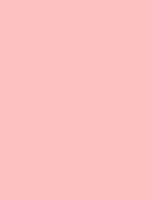#fdc1c2 Color Information
In a RGB color space, hex #fdc1c2 is composed of 99.2% red, 75.7% green and 76.1% blue. Whereas in a CMYK color space, it is composed of 0% cyan, 23.7% magenta, 23.3% yellow and 0.8% black. It has a hue angle of 359 degrees, a saturation of 93.8% and a lightness of 87.5%. #fdc1c2 color hex could be obtained by blending #ffffff with #fb8385. Closest websafe color is: #ffcccc.
-
- R 99
- G 76
- B 76
-
- C 0
- M 24
- Y 23
- K 1
● #fdc1c2 color description : Very soft red.
#fdc1c2 Color Conversion
The hexadecimal color #fdc1c2 has RGB values of R:253, G:193, B:194 and CMYK values of C:0, M:0.24, Y:0.23, K:0.01. Its decimal value is 16630210.
| Hex triplet | fdc1c2 | #fdc1c2 |
|---|---|---|
| RGB Decimal | 253, 193, 194 | rgb(253,193,194) |
| RGB Percent | 99.2, 75.7, 76.1 | rgb(99.2%,75.7%,76.1%) |
| CMYK | 0, 24, 23, 1 | |
| HSL | 359°, 93.8, 87.5 | hsl(359,93.8%,87.5%) |
| HSV (or HSB) | 359°, 23.7, 99.2 | |
| Web Safe | ffcccc | #ffcccc |
| CIE-LAB | 83.4, 21.606, 7.841 |
|---|---|
| XYZ | 69.315, 62.92, 59.53 |
| xyY | 0.361, 0.328, 62.92 |
| CIE-LCH | 83.4, 22.985, 19.946 |
| CIE-LUV | 83.4, 37.75, 7.426 |
| Hunter-Lab | 79.322, 17.167, 11.03 |
| Binary | 11111101, 11000001, 11000010 |
Color Schemes with #fdc1c2
Alternatives to #fdc1c2
Below, you can see some colors close to #fdc1c2. Having a set of related colors can be useful if you need an inspirational alternative to your original color choice.
#fdc1c2 Preview
This text has a font color of #fdc1c2.
<span style="color:#fdc1c2;">Text here</span>This paragraph has a background color of #fdc1c2.
<p style="background-color:#fdc1c2;">Content here</p>This element has a border color of #fdc1c2.
<div style="border:1px solid #fdc1c2;">Content here</div>.text {color:#fdc1c2;}.background {background-color:#fdc1c2;}.border {border:1px solid #fdc1c2;}Shades and Tints of #fdc1c2
A shade is achieved by adding black to any pure hue, while a tint is created by mixing white to any pure color. In this example, #0e0001 is the darkest color, while #fffafa is the lightest one.
-
#0e0001
#0e0001rgb(14,0,1) -
#210102
#210102rgb(33,1,2) -
#340203
#340203rgb(52,2,3) -
#470203
#470203rgb(71,2,3) -
#5a0304
#5a0304rgb(90,3,4) -
#6d0405
#6d0405rgb(109,4,5) -
#800406
#800406rgb(128,4,6) -
#930507
#930507rgb(147,5,7) -
#a60508
#a60508rgb(166,5,8) -
#b90609
#b90609rgb(185,6,9) -
#cc070a
#cc070argb(204,7,10) -
#df070b
#df070brgb(223,7,11) -
#f2080c
#f2080crgb(242,8,12)
-
#f7161a
#f7161argb(247,22,26) -
#f8292c
#f8292crgb(248,41,44) -
#f93c3f
#f93c3frgb(249,60,63) -
#f94f52
#f94f52rgb(249,79,82) -
#fa6265
#fa6265rgb(250,98,101) -
#fb7577
#fb7577rgb(251,117,119) -
#fb888a
#fb888argb(251,136,138) -
#fc9b9d
#fc9b9drgb(252,155,157) -
#fcaeaf
#fcaeafrgb(252,174,175) -
#fdc1c2
#fdc1c2rgb(253,193,194) -
#fed4d5
#fed4d5rgb(254,212,213) -
#fee7e7
#fee7e7rgb(254,231,231) -
#fffafa
#fffafargb(255,250,250)
Tones of #fdc1c2
A tone is produced by adding gray to any pure hue. In this case, #dfdfdf is the less saturated color, while #fdc1c2 is the most saturated one.
-
#dfdfdf
#dfdfdfrgb(223,223,223) -
#e2dcdc
#e2dcdcrgb(226,220,220) -
#e4dada
#e4dadargb(228,218,218) -
#e7d7d7
#e7d7d7rgb(231,215,215) -
#e9d5d5
#e9d5d5rgb(233,213,213) -
#ecd2d3
#ecd2d3rgb(236,210,211) -
#eed0d0
#eed0d0rgb(238,208,208) -
#f1cdce
#f1cdcergb(241,205,206) -
#f3cbcc
#f3cbccrgb(243,203,204) -
#f6c8c9
#f6c8c9rgb(246,200,201) -
#f8c6c7
#f8c6c7rgb(248,198,199) -
#fbc3c4
#fbc3c4rgb(251,195,196) -
#fdc1c2
#fdc1c2rgb(253,193,194)
Color Blindness Simulator
Below, you can see how #fdc1c2 is perceived by people affected by a color vision deficiency. This can be useful if you need to ensure your color combinations are accessible to color-blind users.
